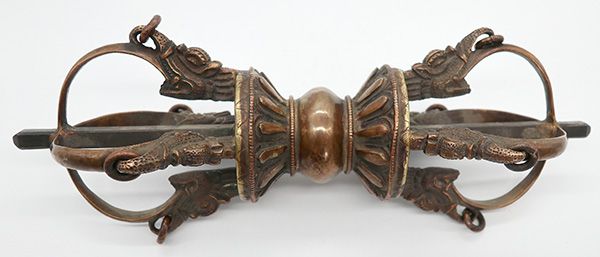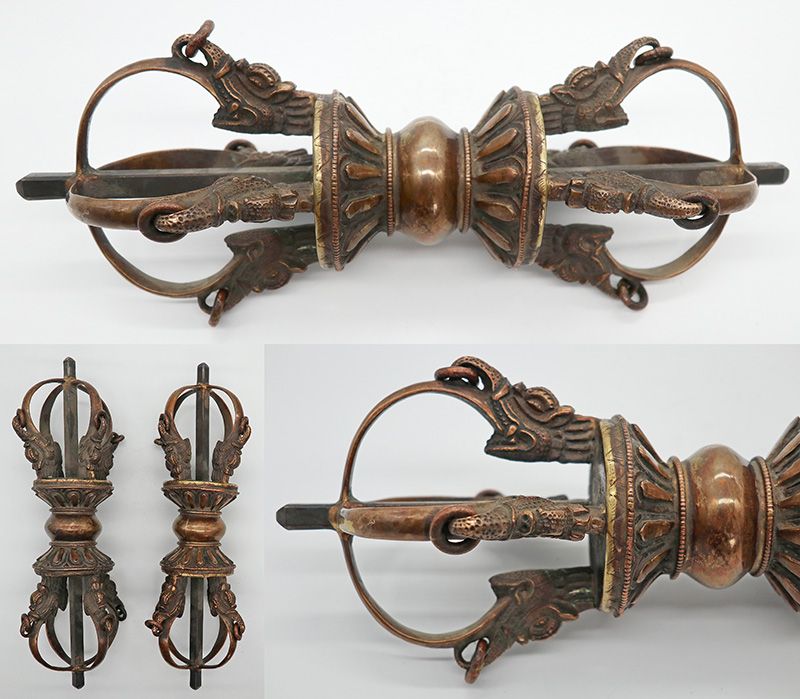Superb Rare Pair of Large Bronze Antique Bhutanese Monastery Vajra or Dorje
SOLD
Rare Pair of Antique Bronze Vajra or Dorje
Combined Weight 2.88 kilos (6 lb 5 ½ oz) Size 31.5 x 11.5 cm (12 ½ x 4 ½ inches).
Rare Pair of Antique Bronze Vajra or Dorje
Combined Weight 2.88 kilos (6 lb 5 ½ oz) Size 31.5 x 11.5 cm (12 ½ x 4 ½ inches).
This magnificent and rare pair of large antique ceremonial Vajra or Dorje were originally acquired in Nepal for myself, and not intended for sale. I was immediately struck by their sacred symbolism, sheer beauty, size and condition, and an inexplicable sense of their potency, but now I am ready to part with them to help fund my humanitarian work in Nepal.

The Nepali antique dealer from whom they were purchased said they were at least 150 years old and would have come from a private Bhutanese Monastery, and placed either side of the main entrance.

These 5-pronged Vajra have been beautifully matched and cast in bronze, then hand finished. The middle prong is made of iron, and prayer flags would have been attached to each of the small rings at the end of the sea monster ‘macaras’. They have a fabulous antique bronze colour and patina.
It is extremely rare to find a matching pair of antique dorje in any size, and these are in exceptional museum quality condition. The buyer will not be disappointed – they are wonderful!
Ritual Object in Tibetan Buddhism
The vajra is a literal ritual object associated with Tibetan Buddhism, also called by its Tibetan name, Dorje. It is the symbol of the Vajrayana school of Buddhism, which is the tantric branch that contains rituals said to allow a follower to achieve enlightenment in a single lifetime, in a thunderbolt flash of indestructible clarity.
The vajra objects usually are made of bronze, vary in size, and have three, five or nine spokes that usually close at each end in a lotus shape. The number of spokes and the way they meet at the ends have numerous symbolic meanings.
In Tibetan ritual, the vajra often is used together with a bell (ghanta). The vajra is held in the left hand and represents the male principle—upaya, referring to action or means. The bell is held in the right hand and represents the female principle—prajna, or wisdom.
Tantric Buddhist Iconography
The vajra as symbol predates Buddhism and was found in ancient Hinduism. The Hindu rain god Indra, who later evolved into Buddhist Sakra figure, had the thunderbolt as his symbol. And the 8th-century tantric master, Padmasambhava, used the vajra to conquer the non-Buddhist gods of Tibet.
In tantric iconography, several figures often hold the vajra, including Vajrasattva, Vajrapani, and Padmasambhava. Vajrasttva is seen in a peaceful pose with the vajra held to his heart. Wrathful Vajrapani wields it as a weapon above his head. When used as a weapon, it is thrown to stun the opponent, and then bind him with a vajra lasso.
Symbolic Meaning of the Vajra Ritual Object
At the center of the vajra is a small flattened sphere which is said to represent the underlying nature of the universe. It is sealed by the syllable hum (hung), representing freedom from karma, conceptual thought, and the groundlessness of all dharmas. Outward from the sphere, there are three rings on each side, which symbolize the three-fold bliss of Buddha nature. The next symbol found on the vajra as we progress outward are two lotus flowers, representing Samsara (the endless cycle of suffering) and Nirvana (release from Samsara). The outer prongs emerge from symbols of Makaras, sea monsters.
The number of prongs and whether they have closed or open tines is variable, with different forms having different symbolic meanings. The most common form is the five-pronged vajra, with four outer prongs and one central prong. These may be considered to represent the five elements, the five poisons, and the five wisdoms. The tip of the central prong is often shaped like a tapering pyramid.
By Barbara O’Brien. “The Vajra (Dorje) as a Symbol in Buddhism.”
SOLD
Compare